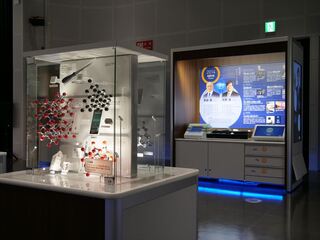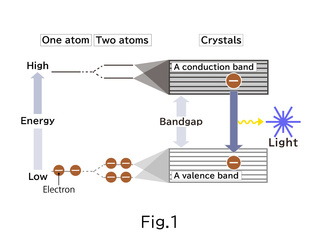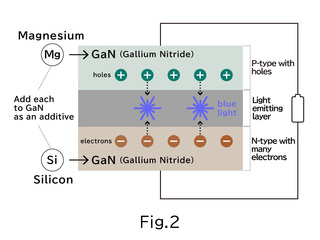Nagoya City Science Museum
TOP > Exhibition Guide > Keyword Search > Starting with "S" > semiconductor > Isamu Akasaki, Hiroshi Amano
Isamu Akasaki, Hiroshi Amano



Purpose of Exhibition
In 2014, Isamu Akasaki and Hiroshi Amano were awarded the Nobel Prize in Physics together with Shuji Nakamura for the development of blue LEDs. The purpose of this exhibit is to help you understand what an LED, or light-emitting diode is; how they succeeded with the difficult development of the blue LED; what its advantages are; and how it is used.
Additional Knowledge
The principle of the LED
Electrons orbiting a nucleus at high speed emit light when they move from a high-energy orbit to a lower-energy orbit (Fig. 1). This is the operating principle of the LED. Gallium nitride (GaN) is known to emit blue light. In order to continue emitting light, it is necessary to provide a flow of current by combining n-type semiconductors, which have excess electrons, with p-type semiconductors, which lack electrons (Fig. 2).
The key to success: Gallium nitride
Zinc selenide and gallium nitride were the two main candidate materials targeted as blue light emitters. Crystalization is the key to exhibiting the properties of a substance. Many researchers chose zinc selenide, which is easy to crystallize, but Akasaki and Amano continued to study gallium nitride, which is difficult to crystallize but more resistant to breakage.
Their challenge was to determine how to grow gallium nitride crystals on the surface of underlying sapphire crystals. Since the size of these crystals (or more precisely, the distance between the lattices) varies, they sought to solve this problem by placing a cushioning material between the two crystals.
Next, small amounts of silicon and magnesium were added to the gallium nitride, and n-type semiconductors and p-type semiconductors were produced. In 1989, these were assembled to finally complete the first blue LED.
Energy efficiency
Blue LEDs are now used in a wide variety of applications. At first, these LEDs were used mainly in traffic lights with the red LEDs and green LEDs already on the market.
Once the three primary colors, red, green and blue, were aligned, light could be produced in all kinds of colors. As a result, a new type of display was made possible, and the white LED was developed to replace the fluorescent lamp. Together, these innovations led to a significant increase in energy efficiency. The potential exists for these to be used not only in displays and lighting, but also in the field of power electronics, such as inverters that convert alternating current into direct current.
The Mystery of Blue Light: The Story of the Development of the Blue LED (2013), Isamu Akasaki, Tokyo, Nihon Keizai Shimbun
Note: The above was published in the Japanese language. The title is translated for convenience.
Koichi Mabuchi, author, curator
